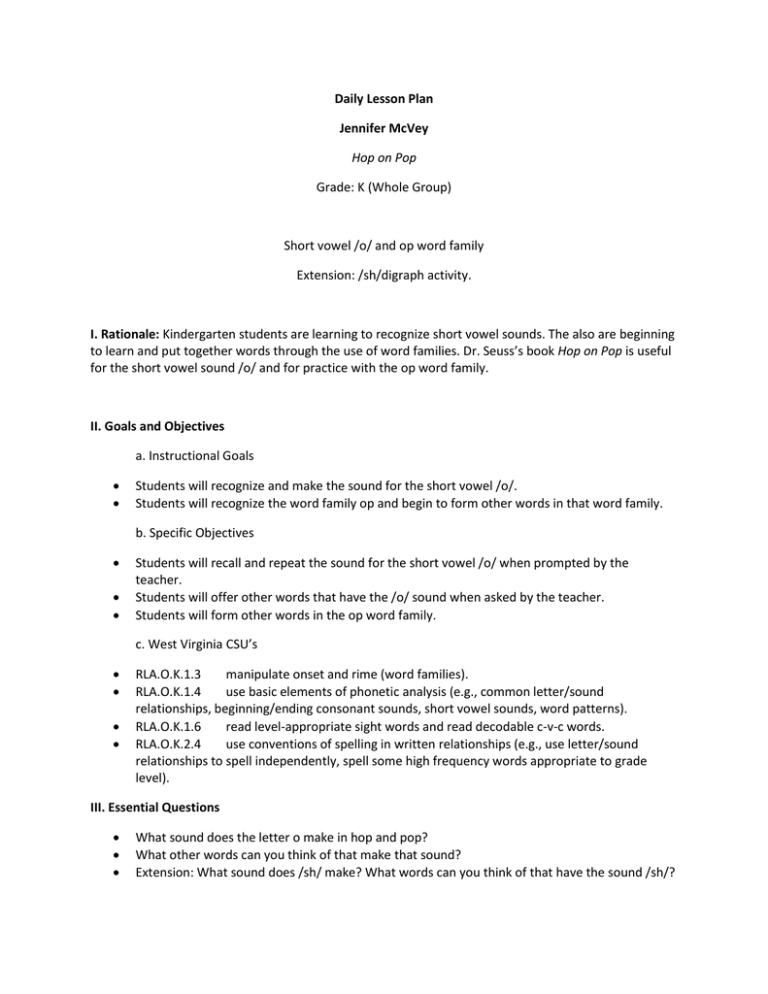hoponpoplesson
advertisement

Daily Lesson Plan Jennifer McVey Hop on Pop Grade: K (Whole Group) Short vowel /o/ and op word family Extension: /sh/digraph activity. I. Rationale: Kindergarten students are learning to recognize short vowel sounds. The also are beginning to learn and put together words through the use of word families. Dr. Seuss’s book Hop on Pop is useful for the short vowel sound /o/ and for practice with the op word family. II. Goals and Objectives a. Instructional Goals Students will recognize and make the sound for the short vowel /o/. Students will recognize the word family op and begin to form other words in that word family. b. Specific Objectives Students will recall and repeat the sound for the short vowel /o/ when prompted by the teacher. Students will offer other words that have the /o/ sound when asked by the teacher. Students will form other words in the op word family. c. West Virginia CSU’s RLA.O.K.1.3 manipulate onset and rime (word families). RLA.O.K.1.4 use basic elements of phonetic analysis (e.g., common letter/sound relationships, beginning/ending consonant sounds, short vowel sounds, word patterns). RLA.O.K.1.6 read level-appropriate sight words and read decodable c-v-c words. RLA.O.K.2.4 use conventions of spelling in written relationships (e.g., use letter/sound relationships to spell independently, spell some high frequency words appropriate to grade level). III. Essential Questions What sound does the letter o make in hop and pop? What other words can you think of that make that sound? Extension: What sound does /sh/ make? What words can you think of that have the sound /sh/? IV. Procedure a. Lesson introduction—Students are listening to and reading books by Dr. Seuss as part of his birthday celebration on March 2. The teacher will introduce the book Hop on Pop by asking students about the author, what they know about him, and what other books they have read by Dr. Seuss. b. Lesson development Read the book Dr. Seuss, asking questions about rhyming words/word families throughout. Pause and ask children about the sound of the short vowel /o/. Ask students to make the sound together. After reading the book, ask students to practice the /o/ sound with you and offer other words that have the same sound. Have the class repeat those words as well. Ask students to offer other words in the op word family. c. Lesson closure Close lesson by reviewing the /o/ sound and op word family. d. Lesson contingency/extension. If time allows, when students are ready for the days writing activities, use the writing practice sheet for the word shop to emphasize /o/ and the op word family. Have students write another /sh/ digraph or /o/word on their papers. e. Pacing guide Reading book and sound/word family practice Extension 15 minutes 10 minutes f. List of questions Who is Dr. Seuss? What books have you read by Dr. Seuss? What sound does the letter o make in hop and pop? What other words can you think of that make that sound? What is a word family? Is op a word family? What are some other op words? Extension: What sound does /sh/ make? What words can you think of that have the sound /sh/? V. Daily Formative Student Assessment Using anecdotal notes checklist, note student sound and word family recognition. Review student writing practice sheets, making notes on checklist. VI. Materials, Equipment and Resources Hop on Pop by Dr. Seuss. Smartboard, ELMO. shop writing practice sheet. VII. Modifications for Diverse Learners One child in the class has an IEP for ADHD. This student will receive extra help and redirection to stay on task from the teacher. One other child is has mild MI. The teacher will provide one-on-one tutoring with this student to practice sounds and writing and recognizing word families.







